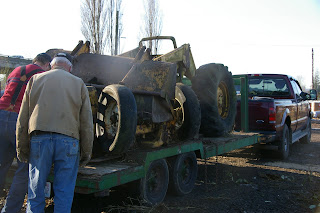The Christian Science Monitor had an article today that points that that pork has been a big thing the internet this year. I can't think of any other time that I've ever heard about pork so many times in so many places. You really can't find anyplace that isn't featuring bacon-wrapped or infused something. You'll find a link to that article at the bottom of this entry.
But for commercial pig farmers the last two years have been horrible. The ethanol-based corn shortage put feed costs up, and the market has been depressed by a lot of farms breeding a lot of pig. I've written about how horrible it's been for dairy farmers, too.
Commercial pig farmers are losing, according to this article, $25 per pig. A commercial pig farmer typically sells to a slaughterhouse, who in turn sells the boxed meat to a distributor, who sells it to a grocery store or restaurant, who sells it to the consumer. Each step along that chain adds a markup, and by the time that it's all done I'm going to guess that the farmer is seeing $.10 of the sales dollar.
I really haven't pursued selling my meat to stores or anything other than direct to the consumer for two reasons: I haven't been able to meet the existing demand for direct sales, and the price offered by most retail establishments has been too low to make any sense.
Offering retail cuts seems to be the direction that I'm heading to. Many of my customers want my product, but can't commit to a whole or half animal, even though they probably eat a half an animal a year.
A CSA (Community Support Agriculture) is an arrangement between a farm and its customers. In return for some money up front, the customers either pick up or have shipped to them a regular supply of the farms products, as they're produced.
To do a CSA I have to transport the animals to a USDA inspected slaughter facility and drop them off. I have to go back after slaughter and pick up the meat, and if I'm dropping off a number of animals, I have to be prepared to transport thousands of pounds of perishable product. And then I have to store that product until I sell it -- which for me will probably mean that I purchase and construct a walk-in freezer.
Then there's the bookeeping, inventory and sales aspects. It's not a small endeavor. Finally, the most important part -- the customers.
This year I will produce something on the order of 300 market hogs, 4 market steers, 30 market lambs, 200 turkeys and around 2,000 chickens.
You'd basically get a shipment every month of something. A typical monthly package might be: 5lbs of ground beef, 2 chickens, 6 lambchops, 2lbs sliced ham. I really haven't thought about the pricing much, but it would be higher than if you purchased the whole or half animals at the farm, to cover the increased costs of production. Say $90 a month.
The goal would be to provide a variety of meats and a sufficient quantity to feed 2 or 4 people. Would you like to see more specific items -- like a "beef csa" "lamb csa" -- animal specific? "chicken csa"?
Would you be more interested in pre-cooked, and willing to pay a bit more for that? Roasted chickens, for instance. Pre-cooked hams. Seasoned lamb chops, ready to broil.
Comments?
You'll find the article here.
1 week ago






















































